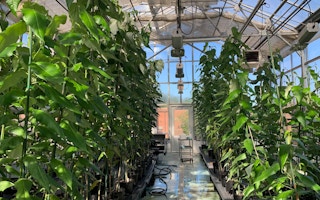Researchers have found a way to more easily extract wood fibre from trees by modifying their genetic code, a feat said to be able to slash chemical use and emissions from the pollutive pulping industry.
To continue reading, subscribe to Eco‑Business.
There's something for everyone. We offer a range of subscription plans.
- Access our stories and receive our Insights Weekly newsletter with the free EB Member plan.
- Unlock unlimited access to our content and archive with EB Circle.
- Publish your content with EB Premium.
Scientists from the United States and China managed to get poplar trees – a species commonly planted in the forestry sector for its fast growth rate – to produce less lignin in their woody stems and trunk. The study, conducted in North Carolina, was published in the Science journal last week.
Lignin is a natural glue that binds tree cells together. The substance frequently needs to be chemically removed during wood pulping to produce paper and textile products. Globally, pulp and paper production contributes to nearly 170 metric tonnes of carbon dioxide emissions a year, along with hundreds of millions of tonnes of chemical waste.
By employing a DNA modification tool called CRISPR, the researchers managed to cut lignin levels by nearly 50 per cent in their test saplings. The ratio of useful carbon material against lignin more than doubled, while the proportion of raw materials the trees use to produce lignin was adjusted to a level more amenable to removal later.
“We are using CRISPR to build a more sustainable forest,” said Professor Rodolphe Barrangou from the North Carolina State University, the study’s co-author.
“CRISPR systems provide the flexibility to edit more than just single genes or gene families, allowing for greater improvement to wood properties,” Barrangou said, in a news release by the university.
Seven different gene editing strategies were trialled. They were picked from almost 70,000 possibilities a computer model had generated, targeting 21 genes controlling lignin production.
Several resultant saplings grew slower than wild-type specimens, the study noted. It said long-term field trials are needed to figure out how their modifications would affect the trees.
As it stands, researchers expect their modified trees to help increase production of a pulp mill by up to 40 per cent, with less raw materials, pulping chemicals and energy needed to maintain output levels.
The global warming potential of a natural gas-powered mill can be up to a fifth lower, researchers projected.
“This study illustrates how strategic multiplex editing to alter wood composition could enable more sustainable fibre production with remarkable operational efficiencies, bioeconomic value creation, and tangible environmental benefits,” they wrote.
Professor Prakash Kumar, a biology expert at the National University of Singapore and chair of Singapore’s Genetic Modification Advisory Committee, said Asian pulp production companies may be keen to explore such technology in the future, since the projected benefits are “vast”.
Kumar, who is not involved in the study, noted that the research only covers a single tree species, and commercial tree types have not yet been edited.
Asia houses several pulp and paper industry powerhouses, including China, India, Indonesia and Japan. Instead of poplar trees, many plantations are instead dominated by acacia and eucalyptus trees.
Pulp production has been linked to deforestation, as forest trees are cut down for wood, or cleared for replanting with commercial species. Such plantations have also been linked to forest fires and episodes of regional haze.
China, Indonesia and Japan have pledged to end deforestation by 2030, though Indonesia has subsequently raised concerns over the target.
While genetically modifying trees to improve industrial efficiency could help reduce land and resource intensity for the wood pulp industry, the practice could also harm surrounding biodiversity if modified plants cross-pollinate with native species.
Kumar noted that commercial trees last for decades, as opposed to quick-turnaround crop species – which have long been subject to genetic testing and modification.
“The long-term effects [of modified trees] are not clear at this stage. Caution is needed, and proper management and monitoring techniques will need to be put in place for forest species,” Kumar said.
He noted that the practice used in the study, where existing genes are switched off, instead of having new genes from other organisms added in, attracts “very little regulation” in North America, and Europe seems to be following suit.
There should be regulations that developers provide proof of no harm where growing modified plants is permitted, he said.








